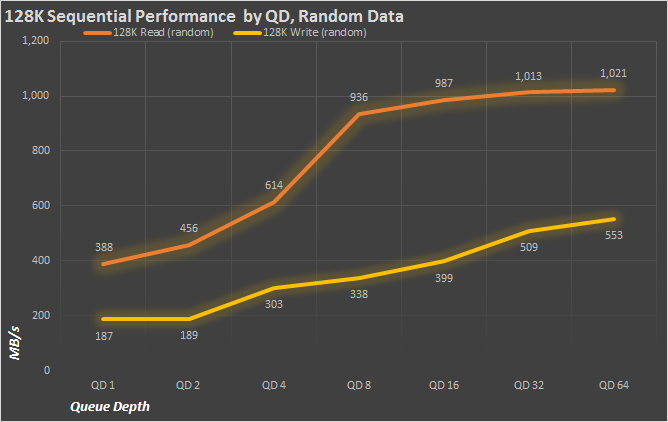While we can’t directly access the two SATA III SSDs on board, data cached on the Nytro MegaRAID’s SandForce-powered eMLC flash modules can be tested indirectly. After ensuring the test file is pre-cached, we can run some basic performance tests that take place exclusively on the SF-2582 controlled drives.
Starting with 128K sequentials using random data, the two cache drives in RAID 0 show trademark LSI SandForce FSP performance. The drives are seemingly optimized for small random performance and not large sequentials, but we still get 1000+ MB/s reads and 550+MB/s writes.
With repeating, easily compressible data, writes really take a step up. On many installations using the Nytro MegaRAID, sequential performance is high enough that the boost we see with caching won’t really be much of a factor. For HDDs like the Toshibas, sequential transfers at larger access sizes are certainly within their wheelhouse. With 24 gigabits of throughput (minus overhead, of course) afforded by the single 4i connection, it doesn’t take all that many HDDs to saturate sequential bandwidth. Let’s move on to 4K.
Obviously, small random performance is the bread and butter of the Nytro MegaRAID card. 85K 4K random read IOPS and 30K 4K write IOPS at QD64 is roughly equivalent to the 4K IOPS of 170 / 60 SAS drives, respectively. It takes a great deal of power to run 170 SAS drives, too. If you can just add a Nytro MegaRAID card to a lower power HDD array, you can get the positive attributes of using lower powered, lower test drives with flash performance on hot data.
The compressible data doesn’t help much for 4096 byte reads, actually showing slightly lower results than with random data. In fairness, there’s a small but measurable variance between runs due to the nature of the testing. Still, the compressible, repeating data helps the 4K write a good bit, adding over 60% over the 4K random write with incompressible data.
 The SSD Review The Worlds Dedicated SSD Education and Review Resource |
The SSD Review The Worlds Dedicated SSD Education and Review Resource | 


Just, WOW !
Another amazing review! Keep up the hard work. I’ve continued to be impressed by the rich content on this site.
Great looking piece from LSI and nice review Chris! What gets me though is the price of the unit. When you consider you can plug a SSD into a 9270 with CacheCade for a considrably cheaper end piece that 1 extra port gained for having onboard nand just doesn’t make fiscal sence.
What would be exciting would be to see the nitro’s flash set to 4 x X Gb units set in R0 nativly, (just like you can already using CacheCade and SSDs without the loss of more ports).
It’s great to see LSI developing their Pcie.3 offering and I look forward to where they take it in the future.